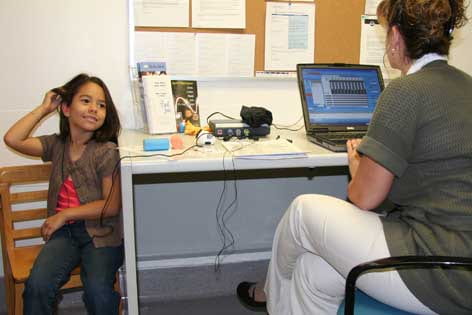Giving them ‘Goosebumps’
Education lecturer Rebecca Constantino launches Access Books to get inner-city kids hooked on reading

Rebecca Constantino was visiting a third-grade class in South Central Los Angeles when she witnessed something disturbing. A 9-year-old boy raised his hand and asked the teacher, “Why is reading so boring?” After class, Constantino followed him to the playground.
“Reading’s not boring, reading’s fun!” she told him. “I’m going to bring you some books, and you’ll see.”
The next day, Constantino brought stacks of books to the school, picking out one in the popular Goosebumps series just for him.
“Kids will think reading’s boring if they don’t have anything good to read,” she says.
To make sure all children have something good to read, Constantino launched the nonprofit Access Books in 2004, distributing books to inner-city schools in Los Angeles, Orange and San Bernardino counties that have pitifully few volumes on their library shelves.
“The best predictor of how well children read is their access to books,” she says. “Reading is tied directly to academic achievement.”
A lecturer in the UC Irvine Department of Education, Constantino began studying the disparity in books among affluent and low-income children in 1994, after completing her doctorate in education from the University of Southern California. She visited Los Angeles-area school and public libraries, classrooms and students’ homes.
“I went to 40 homes in Watts, Compton and Beverly Hills and counted books. Often, kids who lived in low-income neighborhoods had no books on the shelves at home,” she says. “The kids from Beverly Hills had access to 400 times more books.”
When Constantino heard a Brentwood school was discarding books to make room for new ones, she picked them up and delivered them to a school in Compton.
Other principals and teachers heard what she’d done and began contacting her to say they, too, were desperate for books. Could she get them any? That prompted her to hold book drives at affluent schools and deliver books to those in need, filling her VW Passat with as many volumes as it could hold (4,238 by her count, with her daughter in the car seat).
“It wasn’t in my plan to do this out of my car,” she says, “but the need was so great.”
California spends only 71 cents per schoolchild on books a year, she notes, the lowest funding for school libraries in the nation. Funding for school libraries decreased in the state by 92 percent from 1998 to 2003.
“It’s recommended that schools have 25 books per child. Some schools have only three per child. I visited one in Compton that had 330 books for 500 kids.” She added 9,500 volumes to the school library.
Book Access donates about 150,000 books a year to schools as well as after-school centers, homeless shelters, boys and girls clubs – “anywhere kids congregate.” Volunteers from the donating and receiving schools don’t just drop off the books, they give the school library a makeover, showing up on a Saturday to paint murals with the students, who get to pick out a book in return for their labor. For some, it’s the first book they’ve ever owned.
“When all the students go back to school that Monday, they find their library has a new rug, couch, rocking chair and all of these books ready to check out,” Constantino says.
Access Books provides each school with about 10,000 current children’s books; most are proven page-turners, such as Harry Potter and Clifford. With the help of her part-time librarian, Constantino purchases half of the books with grants; the rest come from book drives. She has about 75 schools on a waiting list for books.
“We’d love to go to more schools, but we need groups to step up and donate,” she says.
She encourages people to empty their shelves at home of books their children liked but outgrew – not unwanted discards.
“We want readers to share what they’ve read, what they enjoyed. We don’t want library discards or books from the 1930s,” she says. “We want the kids who receive these books to feel they’re important, that they’re worth a good book.”
While principals, teachers and parents have told her the books make a big difference to the kids, the real proof of the program’s impact comes from the children. Constantino remembers one boy from a Los Angeles school whose teacher warned her he was “a really bad kid.” She began taking him to schools to help paint murals in the libraries, each time rewarding him with more books. Soon, his grandmother noticed he was no longer “running wild” in the streets – he was staying home, reading.
“I asked him why he liked to read, and he told me, ‘Books take me to a world I’ve never known,’” Constantino says. “It made me cry. Of all the days I’ve devoted to this program and the hundreds of thousands of books I’ve moved, if I only saved him, it was all worth it.”

